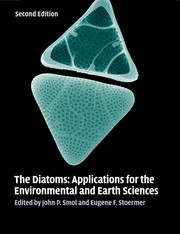Book contents
- Frontmatter
- Contents
- List of contributors
- Preface
- Part I Introduction
- Part II Diatoms as indicators of environmental change in flowing waters and lakes
- Part III Diatoms as indicators in Arctic, Antarctic, and alpine lacustrine environments
- Part IV Diatoms as indicators in marine and estuarine environments
- 15 Diatoms and environmental change in large brackish-water ecosystems
- 16 Applied diatom studies in estuaries and shallow coastal environments
- 17 Estuarine paleoenvironmental reconstructions using diatoms
- 18 Diatoms on coral reefs and in tropical marine lakes
- 19 Diatoms as indicators of former sea levels, earthquakes, tsunamis, and hurricanes
- 20 Marine diatoms as indicators of modern changes in oceanographic conditions
- 21 Holocene marine diatom records of environmental change
- 22 Diatoms as indicators of paleoceanographic events
- 23 Reconsidering the meaning of biogenic silica accumulation rates in the glacial Southern Ocean
- Part V Other applications
- Part VI Conclusions
- Glossary, acronyms, and abbreviations
- Index
- References
23 - Reconsidering the meaning of biogenic silica accumulation rates in the glacial Southern Ocean
from Part IV - Diatoms as indicators in marine and estuarine environments
Published online by Cambridge University Press: 05 June 2012
- Frontmatter
- Contents
- List of contributors
- Preface
- Part I Introduction
- Part II Diatoms as indicators of environmental change in flowing waters and lakes
- Part III Diatoms as indicators in Arctic, Antarctic, and alpine lacustrine environments
- Part IV Diatoms as indicators in marine and estuarine environments
- 15 Diatoms and environmental change in large brackish-water ecosystems
- 16 Applied diatom studies in estuaries and shallow coastal environments
- 17 Estuarine paleoenvironmental reconstructions using diatoms
- 18 Diatoms on coral reefs and in tropical marine lakes
- 19 Diatoms as indicators of former sea levels, earthquakes, tsunamis, and hurricanes
- 20 Marine diatoms as indicators of modern changes in oceanographic conditions
- 21 Holocene marine diatom records of environmental change
- 22 Diatoms as indicators of paleoceanographic events
- 23 Reconsidering the meaning of biogenic silica accumulation rates in the glacial Southern Ocean
- Part V Other applications
- Part VI Conclusions
- Glossary, acronyms, and abbreviations
- Index
- References
Summary
Introduction
Accumulation rates of biogenic silica (BSi) have long been used to infer past levels of primary production (e.g. Charles et al., 1991; Mortlock et al., 1991; Kumar et al., 1995; Schelske 1999; Frank et al., 2000; Anderson et al., 2002; Chase et al., 2003). In some respects, BSi measurements are more useful than organic carbon accumulation rates because 3% of BSi production accumulates in marine sediments (Tréguer et al., 1995), an order of magnitude more than organic carbon (Hedges & Keil, 1995). Biogenic silica is also predominantly produced by diatoms and, because diatoms play an essential role in the export of particulate organic carbon (POC) from surface waters (Goldman, 1993; Buesseler, 1998; Ragueneau et al., 2006; Buesseler et al., 2007), BSi accumulation should contain a signal associated with the strength of the biological pump.
In the mid 1990s, it was recognized, however, that BSi accumulation rates are not a straightforward proxy for primary production (Ragueneau et al., 2000). Although there is a strong link between BSi production and BSi accumulation, variability and shifts in the ratios of BSi to POC during particle production, export, and preservation complicate the extrapolation of primary production from BSi accumulation (Pondaven et al., 2000; Ragueneau et al., 2000; DeMaster 2002; Nelson et al., 2002; Ragueneau et al., 2002; Moriceau et al., 2007).
- Type
- Chapter
- Information
- The DiatomsApplications for the Environmental and Earth Sciences, pp. 454 - 462Publisher: Cambridge University PressPrint publication year: 2010
References
- 2
- Cited by

